

Fluency Resources for Grade-Level Routines. “Fluency in each grade involves a mixture of just knowing some answers, knowing some answers from patterns (e.g., “adding 0 yields the same number”), and knowing some answers from the use of strategies.
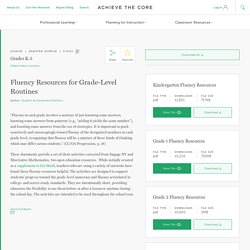
It is important to push sensitively and encouragingly toward fluency of the designated numbers at each grade level, recognizing that fluency will be a mixture of these kinds of thinking which may differ across students.” (CC/OA Progression, p. 18) These documents provide a set of short activities extracted from Engage NY and Illustrative Mathematics, two open education resources. Twitter. 1st Grade Essentials: Basic Fact Strategies. With pages of math standards at each grade level, what is really considered essential learning?
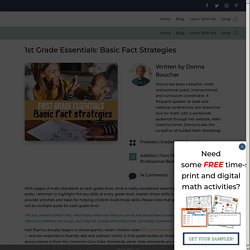
In this series of posts, I attempt to highlight the key skills at every grade level, explain those skills in layman’s terms, and provide activities and tasks for helping children build those skills. Please note that as this series grows, there will be multiple posts for each grade level. This post contains affiliate links, which simply means that when you use my link and purchase a product, I receive a small commission. There is no additional cost to you, and I only link to books and products that I personally recommend.
Twitter. Twitter. Twitter. Developing Automaticity with Basic Math Facts. The standards, whether the CCSSM or the TEKS in Texas, definitively state that students should develop fluency with calculations, and that means automaticity with basic facts.

Knowing math facts is similar to knowing sight words–it frees up the mind to solve real math problems. If a child has to struggle to solve 8 + 3, they have no mental energy (or desire) left to grapple with the types of problems that will increase their capacity as a mathematician. The difference is the approach we now take to teaching basic facts. Traditionally, the emphasis has been on memorization and speed, much to the detriment of countless students. For a great read on the problems with memorization, check out Jo Boaler‘s Fluency Without Fear. The Multiplication Course by Steve Wyborney - Steve Wyborney's Blog: I'm on a Learning Mission. The Multiplication Course by Steve Wyborney is finished and completely ready!
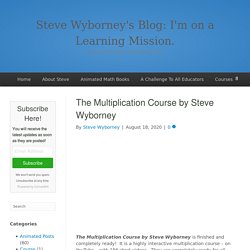
It is a highly interactive multiplication course – on YouTube – with 156 short videos. They are completely ready for all students, all teachers, all parents, everyone! The course teaches students deep, rich, and important multiplication concepts while they are also learning multiplication facts. It also puts students in control of their learning, allowing them to pause the think deeply, allowing them time to write, allowing them to discover important math ideas. The animated videos are organized in 12 chapters – and each chapter is in a playlist on YouTube. Twitter. Reinventing How We Teach Math and Why We Should. MULTIPLICATION BY HEART: Visual Flash Cards by Math For Love. For many kids, rote memorization of multiplication facts is disconnected, boring, and hard.
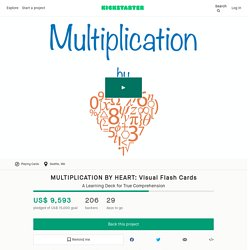
We've got a new take on multiplication flash cards. It's a deeper, more connected, more visual way to learn, so you understand what the equations mean, as well as how to get the right answer. We take advantage of the science of memory to make sure you're actually getting the facts down, accurately and quickly. And we have games, puzzles, and explorations to take the learning further. We call it Multiplication by Heart. Instead of naked numbers or random clutter, we've layered meaningful visualizations of multiplication into the deck, so kids can understand and connect different ways of understanding multiplication to the equations.
The images are simple, beautiful, and clear. The deck has four levels. My daughter’s choice of activity today: Are you offering choice for your kids? Do your kids WANT to do their math? #mtbos #iteachmath #distancelearning #homeschooling… I love this visual! #FastIsntFluent #MelrosePS @BuildMathMinds… Today’s Math Challenge - Sort by Most Efficient Strategy & Create Conjectures (about when to use each strategy) Personal Reflection-recording my questioning helps me hone my skills (e.g., this video reminds me to speak less, maybe walk away, allow for. Tracy Casselman sur Twitter : "We model this @mburnsmath “circles and stars” game during our coaching series using individual whiteboards. But I love this version.What if students cut the paper into personal flash cards with pictorial representations for. The Path to Automaticity with Addition Facts. In recent years there has been a huge shift away from rote memorization of math facts and toward a strategy-based approach for learning math facts.

There’s a big difference between memorizing and understanding. Sure, we want kiddos to have automaticity with their facts. Knowing math facts is similar to knowing sight words–it frees up the mind to solve real math problems. If a child has to struggle to solve 8 + 3, they have no mental energy (or desire) left to grapple with the types of problems that will increase their capacity as a mathematician. A great resource for strategy-based fact instruction is Mastering the Basic Math Facts in Addition and Subtraction: Strategies, Activities, and Interventions to Move Students Beyond Memorization. A big problem with teaching kids facts is that we often jump to the abstract (symbolic) level of instruction too fast.
Learning facts begins in Kindergarten (or PreK) when students are exposed to dot patterns and five-frames. Developing the Concept of Multiplication by Math Coach's Corner. The shift from additive thinking to multiplicative thinking is a monumental leap in mathematical understanding.
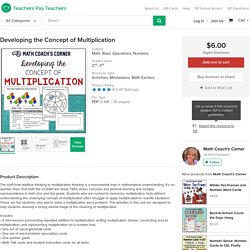
It’s no wonder, then, that both the CCSSM and Texas TEKS stress concrete and pictorial learning and multiple representations in both 2nd and 3rd grade. Students who are rushed to memorize multiplication facts without understanding the underlying concept of multiplication often struggle to apply multiplication in real-life situations. These are the students who add to solve a multiplication word problem. The activities in this unit are designed to help students develop a strong mental image of the meaning of multiplication. Achievethecore.org sur Twitter : "Help your students develop grade-level numeracy and fluency with our math fluency resources, organized by grade (K-5). These activities are intentionally short so that you have the flexibility to use them before/during/af.
De-emphasizing Speed in Math. I recently spoke to the mother of a 1st grade student who told her mom that she was bad at math because everyone in the class could answer so much more quickly than her.
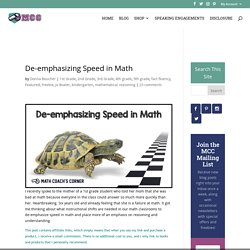
Heartbreaking. Six years old and already feeling that she is a failure at math. It got me thinking about what instructional shifts are needed in our math classrooms to de-emphasize speed in math and place more of an emphasis on reasoning and understanding. This post contains affiliate links, which simply means that when you use my link and purchase a product, I receive a small commission. Berkeley Everett sur Twitter : "Me: I see you wrote 6+8=14, how did you figure that out? S: I added. Me: What did you add? S: The 6 and 8. Me: How did you add them? S: I put them together. Me: What did you do first? S: I took 2 from the 6, put it with the. Multiplication, Division – Math Visuals. How many NOW? Chrissy Newell has a great dot activity to illuminate multiplication through a number talk.
Check out her original post here. Doubling with Multiples of 4, 6, and 8 Doubling, Same/Different. I'm compiling a list of specifically Number Talk resources for teachers who are working on building multiplication fact fluency. See below for what I have so far. What else am I missing? #mtbos. What if we spent the time we use to administer and grade “the mad math minute” to actually sit down with each child FOR a minute so we can listen to their thinking...just a thought. #elemmathchat. Building Fact Fluency…The Right Way. Over the last two years, I’ve been playing around with ways that help build fluency and I am super excited to finally share what I’ve been up to.
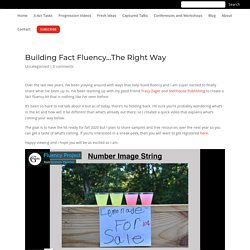
I’ve been teaming up with my good friend Tracy Zager and Stenhouse Publishing to create a fact fluency kit that is nothing like I’ve seen before. It’s been so hard to not talk about it but as of today, there’s no holding back. I’m sure you’re probably wondering what’s in the kit and how will it be different than what’s already out there, so I created a quick video that explains what’s coming your way below. The goal is to have the kit ready for fall 2020 but I plan to share samples and free resources over the next year so you can get a taste of what’s coming. If you’re interested in a sneak-peek, then you will want to get registered here. Happy viewing and I hope you will be as excited as I am. Developing Automaticity with Basic Math Facts. Missing Factor Freebie Multiplication Game. I’m spotlighting another great TpT clip artist tonight, Mr.
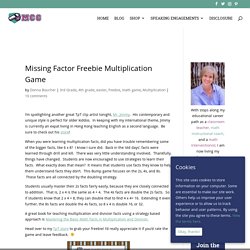
Jimmy. His contemporary and unique style is perfect for older kiddos. In keeping with my international theme, Jimmy is currently an expat living in Hong Kong teaching English as a second language. Math Flips – Math Visuals. Math Flips are flashcards with a problem on the front and a similar problem on the back (instead of a problem and an answer) to encourage relational thinking rather than answer-getting. Math Flips routine: Look at side A: How many? Build fluency through games! I have used these booklets of games for years, but today I had a hard time finding the PDFs on the internet, so I did something about it. Here they are... Memorization vs. Automaticity: Back to Basics or Beyond the Basics? One of the big differences I see between those who tend to side with the “back to basics” group and those who align more closely with the “inquiry and discovery” group is that of memorization versus automaticity. When many think of the word memorization, they think about rote learning; committing information to memory through repetition, speed and without the need for meaning.
While humans memorize a lot of information by rote, this memorization technique is used optimally for memorizing information that is difficult to connect to other information we already know such as memorizing the address or phone number of a family member, Learning new information that can easily connect to our prior knowledge through rote can be truly limiting that new learning for recall purposes only, rather than for understanding. While different people may have slightly different definitions, I really like how Cathy Fosnot describes both memorization and automaticity in her Minilessons series. Addictive Game for Practicing Combinations for Ten. Multiplication Fact Fluency prototype – feedback requested. I am concerned that we are conflating automaticity with fluency. How might we get clear on the difference? From Assessing Basic Fact Fluency by Gina Kling and Jennifer M. Bay-Williams: Think about how you assess reading fluency.
Does your assessment plan involve listening and observing as children read as well as asking reading comprehension questions? Ten More/Ten Less Game. This game for practicing ten more/ten less comes from the wonderful book, Common Core Math in Action (K-2), by Catherine Jones Kuhns and Marrie Lasater. Kuhns is also the author of a terrific book on activities for combinations to 10. Check out this blog post for a game from that book. This post contains affiliate links, which simply means that when you use my link and purchase a product, I receive a small commission. There is no additional cost to you, and I only link to books and products that I personally recommend.
Tonight’s game is Row, Row, Row by Ten. Trying Out Quizlet to Practice Deriving and Recalling Multiplication Facts. Multiplication Subitizing Cards: An Upgrade to Building Fluency. Math Flips – Math Visuals. 4 Steps to Help Our Students Finally Learn Their Multiplication Facts — How We Teach is the Message. Multiplication Move On Game Board (ADAPTED VERSION), Directions, and Math Talk Card.pdf. Math Flips – Math Visuals. Developing Automaticity with Basic Math Facts. Math Fact Fluency: 60+ Games and Assessment Tools to Support Learning and Retention eBook: Jennifer Bay-Williams, Gina Kling: Kindle Store.
Printouts – Math Visuals. Cross Number Puzzles. How to Help Students Heal From 'Math Trauma' Re-Teaching Doesn’t Always Mean Repeating. Addition & Multiplication Move 1 Version 2.pdf. The absolute best way to practice flash cards with elementary students – Teaching With Problems. Fluency Resources for Grade-Level Routines. Becoming the Math Teacher You Wish You'd Had. Strategy-Based Fact Instruction - Math Coach's Corner. It’s heartbreaking when a student not only doesn’t know a fact like 8 + 4, but also has no strategy for figuring it out. Especially when that student is a 5th grader. Most Misunderstood Math Standards in Grade 3.
Online Addition Fact Practice. Fact fluency is an absolutely essential component for young, developing mathematicians. Thankfully, however, math educators are following research and moving away from rote memorization and timed tests. Sum of Which: Promoting Computational Fluency through Game Play. I’m always on the look-out for games that are engaging for students and that promote computational fluency, so I was super excited to try out Sum of Which: A Game of Numbers and Strategy.
The game’s creator, Becky Duprey, sent me a copy of her Sum of Which is Ten Junior game to try in my classroom. Math for Love. Play is best with 2 or 3 players. 180 Ideas #8: Measuring Affection – Mathematically Educated. Online Addition Fact Practice. Online Addition Fact Practice. Missing Factor Freebie Multiplication Game. Array Models for Multiplication. It's All In How You Interpret It.
Fluency Resources for Grade-Level Routines. Using Subitizing Cards to Foster Multiplicative Thinking. I Love Number Lines! The Path to Automaticity with Addition Facts. Computation Dice Games. Kakooma Demo by Greg Tang Jr. Multiples Tic Tac Toe Game. Fluency Resources for Grade-Level Routines. Does Common Core Math expect memorization? Using the apple array. Teaching the Use-Ten Strategy for Multiplication. Teaching the Count-On Strategy for Addition.
FluencyWithoutFear 2015 1. The Best Math Games for Building Fluency - The Brown Bag Teacher. Subitizing to Foster Multiplicative Thinking – Questioning My Metacognition. Tips for Tackling Timed Tests and Math Anxiety. Using Flashcards in Math – Achieve the Core Aligned Materials. Marilyn Burns Math Blog. Marilyn Burns Math Blog. Education Week. 22 Fun, Hands-On Ways to Teach Multiplication. 3 4 4 assessingbasicfactfluency. The Recovering Traditionalist - Working to help teachers think outside the traditional way of doing, and teaching, mathematics. Fact Fluency Part 1: 4 Types of Addition & Multiplication Facts - The Recovering Traditionalist. Nctm.